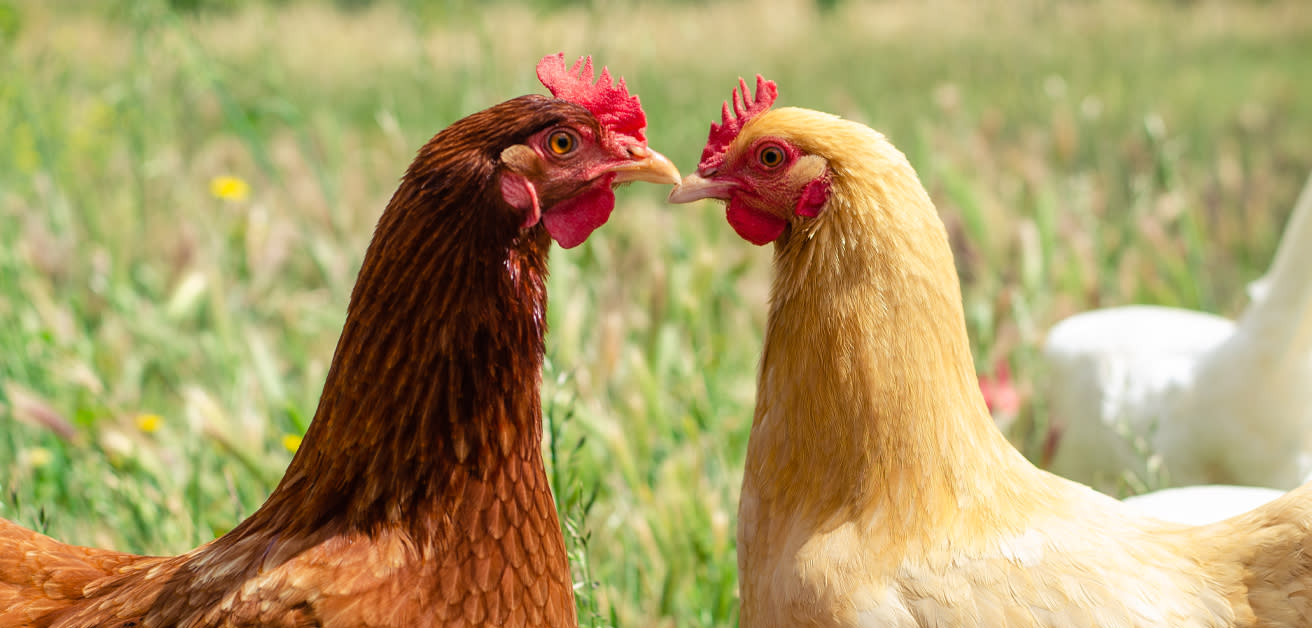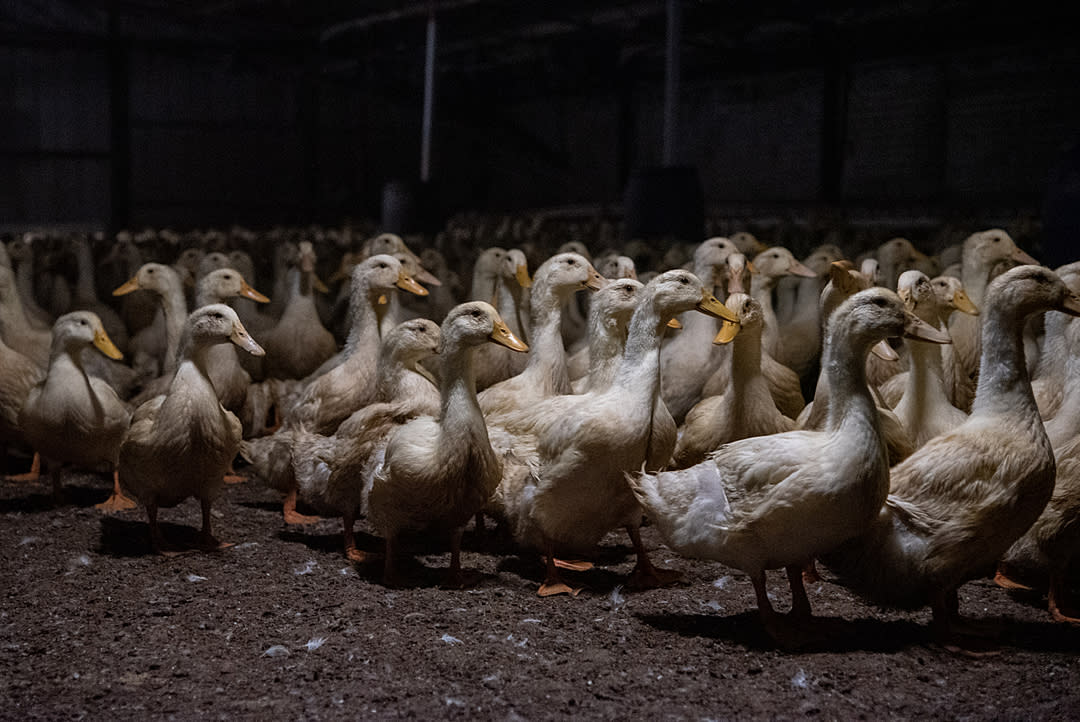




Chickens are highly intelligent, social animals and each has a unique personality, just like a human being. While our broken food system treats chickens as a consumable product, these incredibly diverse creatures have numerous breeds, markings, and traits.

With pithy names like Bantam, Silkie, Welsummer, and Sussex, chicken breeds are far-ranging and varied, with hundreds of varieties around the world. Unfortunately, the vast majority of chickens live the entirety of their too-short lives on factory farms, suffering abuse and seen only as vehicles for meat and eggs.
Of the many chicken breeds around the world, only a few are prevalent on factory farms. But those select breeds represent billions of animals born and bred in cramped, inhumane conditions. Even “cage-free” and “free-range” industrial farming environments are not all they’re cracked up to be, and are riddled with animal welfare concerns.
To better understand the devastating effects of factory farming on these smart, empathetic animals, it helps to know just how extensive chicken breeds are—and how unique each individual chicken truly is.
How many chicken breeds are there?
In short: hundreds. From Bantams to Cresteds and many, many varieties in between, the classification of chicken breeds is both extensive and highly specific. In general, these classifications set the standards for judging at poultry shows, but they also support the work of chicken farmers both small-scale and large-scale. Globally, agricultural organizations like The Australian Poultry Standard lists about 60 breeds of chickens, while The British Poultry Standard recognizes 93 chicken breeds. Somewhat differently, the American Poultry Association categorizes chickens in six classes:
- American
- Asiatic
- Continental
- English
- Mediterranean
- All other standard breeds (AOSB)
While these organizations, and others like them, maintain unique poultry databases (and set country-specific standards to ensure the genetic integrity of “true” chicken breeds), it’s worth noting that animal welfare is not their primary concern.
Within those designations, there are a wide range of chicken breeds with names like Chantecler, Australorp, and Rhode Island Red. And those are just the recorded breeds: many other varieties exist in backyard or other farming communities around the world. Much as chickens have unique personalities, these curious, empathetic, and funny animals have unique plumage, coloring, sizes, and naming conventions, too.
How do I identify a chicken by its breed?
From coloring to plumage, identifying a chicken by its breed begins by observing their look. For example, the rich orange-brown color of the Rhode Island Red is a sharp contrast to the white-and-black-striped Plymouth Rock (or the Speckled Ranger). The most typical, or common, chicken breeds vary from region to region around the world, so it also helps to have a sense of where a chicken is typically raised to identify them by their breed.
Common chicken breeds
With hundreds of breeds of chickens spreading their wings around the globe, identifying common breeds differs from region to region. In the US, some of the most commonly known breeds are:
What is the friendliest breed of chicken?
Chickens are, overall, friendly animals. They are curious and kind, can have unique and hilarious personalities, and have a strong capacity for forming friendships. Of the hundreds of chicken breeds worldwide, some are generally considered especially friendly and gentle. Those include:
Unfriendly chicken breeds
As with humans, some chickens are a little more easy-going than others. Some have garnered a reputation for cantankerous behavior, including breeds that were originally bred for cock fighting, a brutal practice that is illegal in the US. Aside from breeds like Modern Game, American Game, and Old English Game, the list of potentially unfriendly chicken breeds includes:
What are the 4 different types of chickens?
Chicken breeds fall into four broad categories. Those largely depend on how the chicken will be raised, and for what purposes: whether for meat, eggs, or show. The concept of “breed,” in this context, is a corporate term. It doesn't reflect the unique characteristics, bold personalities, or colorful feathers of each and every chicken.
1. Meat breeds
Commonly referred to as broilers, fryers, or roasters within the poultry industry, “meat breeds” are those who are bred for human consumption. Most of these chickens are bred to grow quickly, and are slaughtered within six to eight weeks of life. During their too-short lifespans, broiler chickens endure incredible suffering. Because chickens are selectively bred to promote rapid growth, broiler birds also endure a syndrome known as white striping disease—a widespread disease that remains evident in supermarket chicken meat today.
2. Egg-laying breeds
Female chickens, or egg-laying hens, are often used to produce eggs for human consumption. In a factory farming environment, egg-laying hens are selectively bred to produce high volumes of eggs: about 300 eggs per year for a single hen. Laying eggs—a process that takes 22-26 hours per egg—is exhausting for hens, and uses more calcium than their bodies can naturally produce. Most hens stop producing eggs by the time they’re two years old, and that’s often when they’re sent to slaughter.
3. Dual-purpose breeds
Dual-purpose chickens are hens bred to provide both meat and eggs. Those raising dual-purpose chickens may allow the chickens to gain weight naturally during their egg laying years, then slaughter them for meat.
4. Exhibition/show poultry
Much like raising dogs to exhibit, train, or show, some people raise chickens as show poultry. As with chickens raised as pets, “show chickens” require a standard of care just like any other domesticated animal. Bantam chickens, for example, are often kept as ornamental chickens, or pets for exhibition and show. Bantams are known to be funny, intelligent, and caring birds.
At what age do chickens start breeding?
Chickens can start breeding as soon as they are old enough to lay eggs. Pullets—the term for hens under a year old—generally begin laying eggs at about 18-20 weeks of age, but may not begin laying eggs until they’re 20-21 weeks old in a stressful industrial or factory farming environment.
Roosters generally reach maturity around 20-24 weeks of age, but most chickens in the agricultural industry are artificially inseminated to lay fertilized eggs. Those fertilized eggs, in turn, hatch baby chicks in about 21 days.
How farmed chickens are raised
It’s unfortunate but true: chickens raised on factory farms exist solely to produce eggs and meat. Because their production is prioritized over their wellbeing, chickens endure horrific abuse in industrial farming environments. Most factory-farmed chickens spend the entirety of their short lives indoors with no fresh air or sunshine. Egg-laying hens live in crowded cages with four to ten other birds.
Broiler chickens
The industry term for chickens raised for meat is “broilers.” Broiler chickens are selectively bred to grow large pectoral muscles, and are slaughtered for their white meat or chicken breasts. Because these birds are raised solely for meat, they are bred to gain weight rapidly, which can cause pain and health issues for the near-entirety of their too-short lifespans.
Egg-laying hens
Sometimes referred to as “layer hens” within the egg industry, egg-laying hens are female chickens who produce eggs for human consumption. Of hundreds of chicken breeds, Hybrid White Leghorns have become popular on factory farms because of their ability to produce high volumes of large eggs. Most of these factory farmed hens are confined in battery cages with four to ten other birds, wire digging into their feet, and without enough room to spread their wings.
Cage-free chickens
The term “cage-free” suggests that chickens can roam freely, without being confined in a cage. “Enriched cages” are another common term in the agricultural industry, but they are only a little better for chickens than life in a battery cage. Cages with enrichments have areas like scratch boxes and/or perches to allow chickens a little more room to spread their wings. In a cage-free environment, chickens can perch on multi-level aviaries—but they are still housed inside. So while a cage-free environment offers a slight improvement over life in a battery cage, without outdoor space to roam, take a dust bath, and feel the sun on their feathers, it’s still not an ideal scenario for chickens.
Are there such things as free-range eggs and meat?
Unfortunately, free-range doesn’t mean a life of freedom for egg-laying hens or broiler chickens on factory farms. Egg cartons with “free-range” on the label mean that the chickens who produced the eggs were allowed outdoor access. But to apply the USDA "free range" terminology to their packaging, factory farms can provide even just a small, barren outdoor space, and can choose to allow only minimal outdoor access.
While a free-range environment beats life in a battery cage, every chicken in a factory farming environment will eventually go to slaughter—and those who must endure live-shackle slaughter meet an incredibly cruel end.
How can I help?
Learning about the vivid, unique characteristics of chickens and their various colorful breeds helps further understanding that these sentient beings deserve kindness and respect. While some egg-laying hens (like Bobby Bob Bob) get their stories told, many do not. By sharing knowledge, furthering understanding of chickens as individuals, and appreciating the diversity of their breeds, we’re working together to sow the seeds of compassion.
Because the global demand for cheap eggs and meat fuels factory farming, we can make a difference by choosing to leave animals (and eggs) off our plates.
We can also work together to advocate for better animal welfare policies. The future is cage-free, and animal activists around the world are building momentum to effect change for chickens. Join the movement by taking action with us, and let corporations know it’s time to end the use of cages for good.





